Transplanting bushes
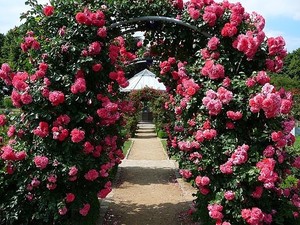 It is known that it is not always possible to guess with a suitable place for rose bushes, but transplanting adult bushes is often not advised, if only for salvation. Autumn is a good time for transplanting (the last days of September - early October). These deadlines must be met in order to preserve the plant and give it time for full rooting.
It is known that it is not always possible to guess with a suitable place for rose bushes, but transplanting adult bushes is often not advised, if only for salvation. Autumn is a good time for transplanting (the last days of September - early October). These deadlines must be met in order to preserve the plant and give it time for full rooting.
When transplanting from one place to another in spring, you should choose an early time, while the buds on the shoots have not yet had time to awaken.
When the time for transplanting has come (in autumn), the lashes should be removed from the support, the bushes should be widely dug around the root, then the plant should be removed. Trim all torn hairy roots with pruning shears. In a new place, straighten the root system, cover it with fertile soil, tamp the soil and water generously. A few days after transplanting, you should additionally spud the bushes, and then repeat this procedure before winter.
When transplanting Rambler, young shoots are left intact. One has only to pinch the tops of the shoots in advance, back in August, to accelerate their lignification. Two-year-old shoots are cut off completely. The varieties of Claymers and Climings are transplanted according to a similar scheme, only long shoots in their case should be shortened by 50%.
Features of planting a climbing rose in the Moscow region, Siberia, in the Urals
Depending on the place of growth, the roses require special care.
Ural
Growing roses in the Urals will be successful if you follow the rules for caring for the shrub.
- Top dressing. During the growing season, the flowers are fed at least 3 times (in June - using an infusion of mullein, in July - nitrogen-phosphorus potassium fertilizer, in early August - superphosphate and potassium).
- With the onset of the autumn period, abundant watering stops.
- In the Urals, it is better to cover the bush in advance: 2 weeks before the establishment of sub-zero temperatures. All green twigs, flowers and leaves are removed from the shrub. They remove the shelter at the beginning of May.
- In general, the plant needs to be looked after in the usual way: water, weed, loosen.
Note! If the seedlings were purchased with wax-covered stems, packed with roots, then they can be stored in the basement. To prevent the roots from losing moisture, you need to open the package and add some water there.
Siberia

In landscape design
Since the Siberian spring is late, the land often does not have time to warm up to the desired temperature, it is recommended to plant roses in the southern areas. During the day, it is recommended to hide the plant so that the buds do not fade.
It is advisable to plant them so that there are walls or a gazebo nearby. This will help shield the plant from strong winds. In addition, elevated areas are chosen so that the earth does not have time to freeze.
Moscow suburbs
In the Moscow region, overwintering of climbing roses is much worse than in warm regions. Due to the short summer, the shrubs do not have time to fully prepare for winter. The bark of the branches is more watery, loose. Nutrients are lacking. Therefore, plants need good shelter.
Thus, proper planting and care plays a key role in the abundant flowering of roses, which will allow gardeners to grow magnificent flowers on their sites, which will delight with beauty and aroma for a single year.
vote
Article Rating
Support for climbing roses
There are a huge variety of supports for this type of rose. So, as a support, you can use an old dried tree, a wooden, metal or polymer arch or lattice, as well as arched rods made of metal.But the best support for such a plant is a building or any structure, but we must remember that plants should be planted at least 50 centimeters, stepping back from the wall. On the surface of the wall, it is necessary to fix the guides to which the shoots of the plant or the lattice will cling. But at the same time, one must not forget that if the stems are located horizontally, then the flowers will grow along their entire length. If they grow vertically, then the flowers will bloom only at the tops of the stems.
In order to fix the stems on the support, it is necessary to use plastic twine. It is forbidden to use wire for these purposes, even if wrapped in a cloth or a sheet of paper. The shoot must be fixed on the support securely, but so that the fastening material does not damage it. Plants should be systematically inspected for the integrity of the fastening materials. The fact is that under the weight of the plant itself or from gusts of wind, the twine can break, and in this case there is a risk of the rose getting significant damage. Step back 30 to 50 centimeters from the bush and then dig the support into the ground.
Care and cultivation of a climbing rose

Rose care
There is an ornamental type of perennial shrub called a climbing rose. Despite the fact that roses are similar to each other, they still have some differences:
- curly rose reaches 15 m in length;
- the stems are able to cling to the support themselves due to the antennae;
- the bush is easy to form.
To grow a beautiful and healthy bush, you need to know about the important points:
- You need to plant a rose in a sunny, ventilated place. Optimally south and southwest side. Under the most comfortable conditions, the rose will begin to bloom in the second year.
- Open ground should be fertile with drainage.
- You need to plant the bushes at a distance of at least 50 cm from each other. Over the years, the roots will have little room, and they will deplete the soil around the bushes.
- For a healthy and well-formed bush, timely pruning is needed. Pruning is recommended in late August - early September.
- The garter of the rose takes place at an early stage to control the direction of growth of the shoots.
- The curly rose is frost-resistant, but it still needs to be wrapped in the winter. Preparation for wintering begins in the fall. To begin with, the loosening of the soil and its fertilization stop. The number of waterings is also decreasing. Bushes take refuge during the onset of the first frosts. In order for the rose to withstand the cold well, when wrapping it up, it is worth leaving an air gap between the film and the crown.
- If it is possible to remove the rose from the support, it can be rewound with twine and laid on a layer of leaves. Top is also covered with leaves, burlap or oilcloth.
- Most often, climbing roses are planted in groups. There should be no other types of flowers nearby. Trees are considered an exception - apple, pear or mountain ash.
Note! If the curly rose is firmly attached to the support, do not try to remove it. Such actions can damage the shoots.
The rose is covered with a fir tree and wrapped in burlap.
Features of caring for a climbing rose in the first year of growth
Usually, roses planted correctly in the ground do not bring much trouble. They are actively moving into growth, they only need to be watered with warm water on time. But sometimes, a young seedling freezes and does not grow. Or gives new leaves and they immediately dry up. Such a seedling needs help.
- be sure to shade the seedling;
- water daily with lukewarm water;
- mulch the trunk circle;
- spray or water with a solution once a week, adding epin, zircon, HB-101 and other stimulants.
Important! If the seedling is weak and has not grown enough, but is about to bloom, then it is better to cut the buds so as not to weaken the rose.
Climbing rose care
Cuttings or cuttings of a rose will require much more attention.
Reproduction
You can plant a rose garden by seed, by means of cuttings, layering and by grafting.The main thing is to know the features of each method.
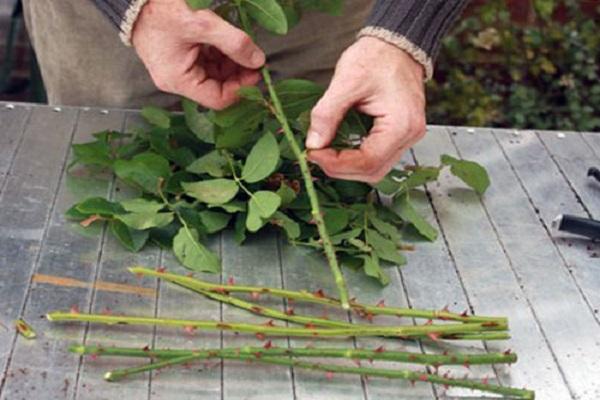
Seeds
First of all, the seed should be disinfected by keeping it in a hydrogen peroxide solution for 30 minutes. After that, you need to place the seeds between two cotton pads dipped in hydrogen peroxide, and put one sandwich in plastic bags. After signing them, you need to put them in a container and put them in the refrigerator on a vegetable shelf.
The seeds are periodically inspected, and if mold is detected, cotton pads are replaced. You can expect the emergence of sprouts as early as 6-8 weeks.
Sprouted seeds are planted in peat pots and perlite is placed on top of the soil, which will prevent the black leg from developing. The containers are placed in a well-lit place and, as the top layer of the soil dries up, they are watered. The formation of the first buds is possible in 8 weeks after planting, and flowering in 4-6 weeks. Landing in a permanent place is performed in the spring.

Cuttings
The most common and easiest way to propagate climbing roses is by cuttings, even a beginner can handle it. Stems that have already faded and those that are still blooming are suitable as blanks. They are cut in late June and early August at an angle of 45 degrees. The lower oblique cut should be under the kidney, and the upper one should be made straight away from the kidney.
The material should have from 2 internodes. The upper leaves are shortened by half, and the lower ones are removed. The cuttings are buried in the ground by 1 centimeter, it should consist of sand and earth or sand alone. To create a greenhouse effect, it is covered with a glass or plastic container. The stalk should not be in direct sunlight, but it should be well lit. Water it periodically.
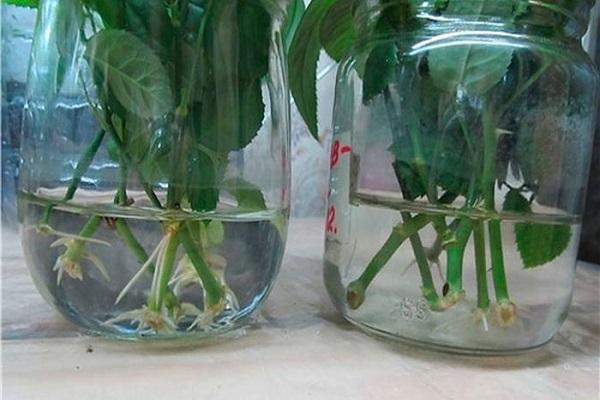
Layers
In spring, an incision of the stem should be made above the bud so that the depth and width are 10-15 centimeters. Then a layer of humus is poured into the groove and covered with soil. In this case, the escape must be securely fixed in two or three places. The main thing is that its upper part remains open. The cuttings are irrigated regularly, and the following spring are separated from the mother plant and planted in a permanent place.
Rosehip grafting
Budding is performed in late July-early August. Before the procedure, the rosehip is abundantly moisturized. After that, a T-shaped incision is made on the root collar.
At this point, the bark is carefully removed, and a peephole with a part of the bark and wood is placed in the incision, taken from the stem of the rose. Then they wrap it with budding material and huddle the rosehip bush, adding soil in such a way that the grafting zone is covered by at least 5 centimeters. After half a month, the bandage is admitted, and in the spring it is completely removed.
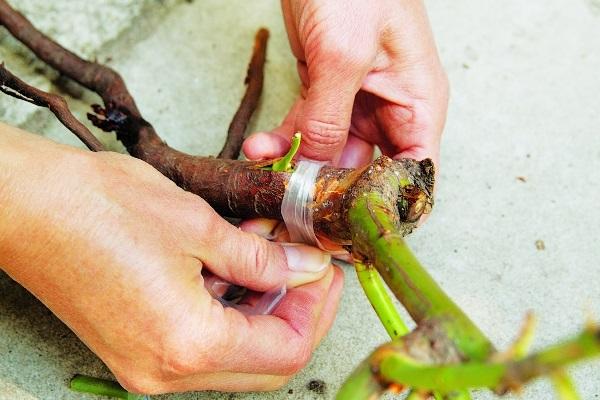
How to properly plant a climbing rose in summer and autumn
How to plant climbing roses in summer? The summer period is considered not entirely favorable for planting these flowers, so at this time it is better to buy seedlings in pots. In hot weather, you need to especially monitor soil moisture.
Important! If the rose is not watered, it may not take root. But you also can't drain the bush too often, otherwise the roots will begin to rot.
Planting a climbing rose in autumn is also possible. In this case, a seedling with both open and closed root systems is used. When planting, you need to carefully inspect the roots for rot. Long roots should be shortened, patients are pruned until the cut turns white.

How to properly plant a climbing rose
Usually in the autumn, planting work is done in September or October. If you plant seedlings earlier, then the plant will begin to actively develop, but this process will stop in the root system. As a result, the rose may even die. And at later dates of planting, the plant often does not take root.
How to cover a climbing rose for the winter
One of the important procedures for caring for a rose is its shelter for the winter. In frosts, the flower runs the risk of dying, so you need to cover it on time and correctly.
With the onset of the first cold weather, the growing season of roses stops. But since the weather is changeable, and the temperature can rise, provoking sap flow, then with the subsequent cold snap the juice freezes, which causes the stems and roots to suffer. As a result, the rose dies. But you can't wrap your roses too much, you should definitely leave oxygen access. This will quickly dry the protruding sap and heal cracks, if any.
Preparation for wintering
In early August, you need to feed the rose bushes. A nutrient solution can be made from the following ingredients:
- superphosphate - 25 g;
- boric acid - 2.5 g;
- potassium sulfate - 10 g.
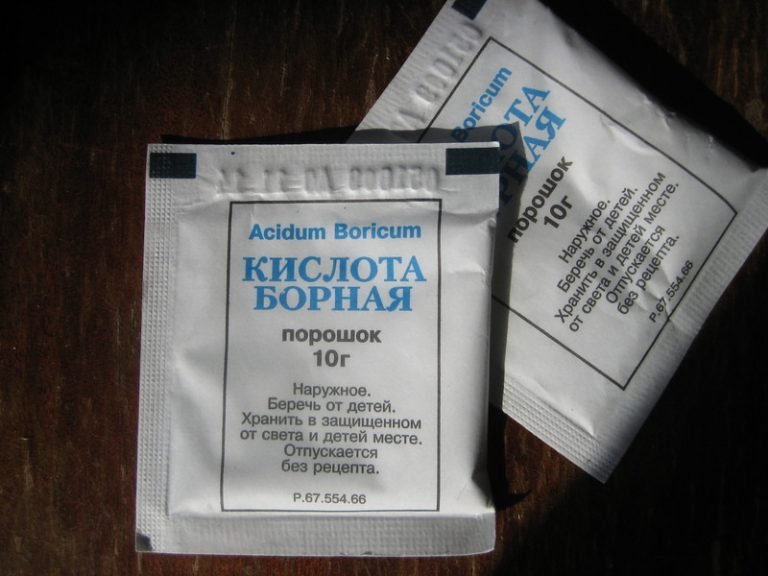
Boric acid for roses
Everything is diluted with 10 liters of water. This volume is enough for 4 m² of land.
In September, another top dressing is performed:
- superphosphate - 15 g;
- potassium sulfate - 16 g.
Also dilute with 10 liters of water.
Shelter methods
One of the most successful shelter methods is considered to be the laying of wooden shields in the form of a roof. This method is suitable for roses that can be removed from the support. The most suitable canvas should be 80 cm high, the length depends on the size of the bushes. In order for the structure to stand securely, pegs are driven into the ground for support. The use of wooden boxes is allowed. In the first and second methods, you need to additionally cover the top with a film.
Important! With this type of shelter, it is important that the shoots do not come into contact with the boards, as moisture can accumulate on them. This is fraught with the fact that the flower will become infected.
Can be covered without building structures. The shoots are carefully removed from the supports, cut off, collected in one shock, tied with a tourniquet and laid on the leaves. A mound of soil mixed with peat is made near the root. You can cover the top with spruce branches or cover with dry leaves. Cover with a film on top.
If it is not possible to remove the rose from the support, pre-cut dry branches, weak sprouts, pluck the leaves, then wrap them with spruce branches (spruce), top with burlap or foil and tie them with a tourniquet.
When using high-quality materials and properly wrapping the climbing rose, you can not worry, since the flower will survive the winter frosts 100%.

Shelter
Climbing rose care in the first year
How does it differ from standard requirements? The further development and splendor of flowering depends on competent care in the first year of a plant's life. When new shoots appear, the soil is removed from the bushes (the one that was used for hilling). If there are sunny days, then at first, light shading with coniferous spruce branches will not hurt. After 10-12 days after removing the hilling soil, you can start the first pruning of the central shoot. It should be shortened over the second or third sheet. A little later, with the lateral branches of the second order, you need to do a similar procedure, while the eyes "looking" inside the bush must be removed, and those eyes that are located on the outside are left for the further correct formation of the bush.
Caring for a climbing rose in the first year also involves removing the buds, as odd as it sounds. From the beginning of flowering until the first weeks of August, it is recommended to leave only two flowers on each branch. With the arrival of autumn, these flowers will turn into boxes with seeds (fruits), and after the manipulations carried out, your rose will bloom especially magnificently next year.
In summer, preventive irrigation should not be neglected against the invasion of parasites, and with the onset of autumn, rose bushes should be covered. Lutrasil, spunbond or coniferous spruce branches are an excellent covering material for this plant. The bush is completely covered. When a new spring comes, young bushes are opened first, older representatives - later. In principle, all climbing rose bushes are sheltered for the winter.An old proven method is hilling with earth and sand (1: 1) to a height of about 30 cm, with the arrival of autumn, and a little later - full cover with the onset of the first frost.
Autumn planting

If you are going to plant a climbing rose, you must first learn how to choose the highest quality planting material. Nowadays, you can buy seedlings of roses that are self-rooted, as well as those that are grafted onto rose hips.
But how are they different? Grafted seedlings have one important difference from self-rooted ones. The fact is that the root system of such a seedling belongs to the dog rose, and on it there is a scion belonging to a varietal climbing rose
In this regard, planting and caring for a self-rooted rose should be somewhat different than for a grafted one. So, for example, a grafted seedling must be buried in the soil during planting in such a way that the place where the graft is located is underground at a depth of 10 centimeters. With this method of planting, the part of the plant that was grafted begins to form its own root system, while the roots of the rose hip eventually become unnecessary and die off. In the case when, during planting, the scion was not buried in the ground, but remained above its surface, it can lead to the death of the plant. The fact is that the wild rose is a deciduous plant, and the grafted rose is an evergreen. If the planting was carried out in violation of the rules, then such a discrepancy between the rootstock and the scion can lead to the death of the cultivated part of the plant.
Seedlings with an open root system must be immersed in a container of water for 1 day, and this should be done immediately before planting in open ground. After that, you should cut off all the leaves and cut off, using a pruner, those stems that are unripe or have been damaged. You should also trim the root system and the aerial part, leaving 30 centimeters each. Places of cuts should be treated with crushed charcoal. If you use grafted seedlings for planting, then they must carefully remove all the buds that are located below the scion. The fact is that rosehip shoots will begin to grow from them. Next, the planting material should be disinfected. To do this, it must be dipped in a solution of copper sulfate (3%).

The hole for planting a rose should be 50x50 in size. At the same time, a distance of at least 100 centimeters must be maintained between the planting pits. The top layer of soil most saturated with nutrients must be removed from the dug hole and combined with ½ part of the manure bucket. Part of the resulting soil mixture must be poured into the hole, and then a relatively large amount of water must be poured into it. This procedure must be carried out a day or two before the expected planting of the plant. On the day when you are going to plant a seedling, you need to prepare a special solution in order to process the root system before planting. To prepare the solution, dissolve 1 tablet of heteroauxin, 3 tablets of phosphorobacterin in 500 ml of water.
Then pour this liquid into 9.5 liters of clay talker. Before the seedling is lowered into the hole, its roots should be dipped in the prepared mixture. A mixture of soil and manure should be poured into the hole with a mound. Then you need to place a seedling in the hole, while carefully straightening its roots. Fill the hole with the same mixture of soil and manure and compact the surface of the soil well. Do not forget that the place where the graft is located must be buried 10 centimeters into the ground. In this case, for a self-rooted seedling, the root collar must be buried 5 or more centimeters into the ground. The planted plant must be well watered. After the liquid is absorbed into the soil, it will be necessary to add a mixture of soil with manure to the hole. Then the plant spuds to a height of 20 centimeters or more.
Additional factors
Growing a climbing rose requires mandatory warming before wintering.Before covering the bushes, they need to be properly prepared. To do this, it is necessary to remove dry leaves, cut off old branches and weak shoots. As a result, only 10-12 strong shoots remain. All actions should be carried out only in dry weather.
There are different methods of covering roses. Their choice depends on the region where the roses grow. If the climate is milder, then the branches can not be removed from the support. They are allowed to be covered with spruce branches, and then wrapped in additional film.
If the winter is too cold in the region, then the branches are supposed to be removed from the support. First you need to collect them in a large bunch and tie them. When the temperature drops to 5 ° C, then this bundle must be carefully tilted to the ground and fixed with stakes and wire. The base of the bush must be covered with a mixture of soil and peat, and the shoots must be covered with spruce branches. Cover everything from above with agrofibre or foil.
In the spring, it is important to remove the entire structure on time. Otherwise, without fresh air and with high humidity, the roses will simply suffocate and rot.
After opening the bush, the shoots must be tied back to the support. The first feeding should be introduced only after the young leaves appear.
Prevention of disease.
If you take care of the bushes incorrectly, then powdery mildew, black spot or bacterial cancer can develop. These are the most common diseases of climbing roses. Be sure to follow all the rules for caring for the plant. In addition, all dry branches and leaves must be burned, otherwise the disease will pass from them to new shoots and flowers. In addition, you need to use chemicals and folk remedies.
Diseases and pests of roses

Often, when growing a crop, problems arise with various ailments and parasites who have chosen a climbing rose for living. The following table will tell you what to do and in what cases.
Plant diseases and pests
| Name | How to fight |
| Aphid | A solution of laundry soap helps well against aphids. Grate part of the bar into a container, pour water and leave for 24 hours. Strain the solution and use for spraying. |
| Spider mites | Tobacco, makhorka, wormwood and yarrow. Any of the means used in the form of an infusion will do. Any of the components is taken in an amount of 0.5 kg, filled with cold water and fermented for 5-6 days. Then the solution is filtered, diluted with 10 parts of water and used to treat plants and the area around shrubs. |
| Coniotirium | A fungal disease characterized by reddish-brown spots on the bark. Affected shoots must be cut and burned. |
| Bacterial cancer | There is no cure, but as soon as the disease is detected, you need to get rid of the plant as soon as possible. The most striking symptom is the appearance of soft growths in the form of tubercles, gradually they become very hard |
| Powdery mildew | It is characterized by the presence of a white bloom, gradually the bloom becomes brown and destroys the part of the plant where it was formed. Removal of diseased leaves or shoots is recommended. Spraying with copper sulfate in the form of a 2% solution can be used. At least 2 liters per plant |
How to properly care for a climbing rose outdoors
Like all ornamental plants, climbing roses require some care.
In order for the flowers to delight the owners of the site with their abundant flowering for several years, it is important to know some of the subtleties
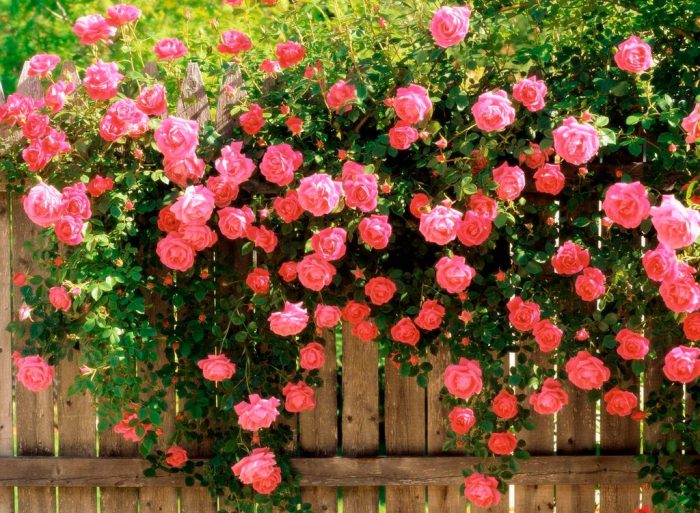
Climbing roses
Climbing rose care in the first year
The first year, roses take root and do not always delight with flowering buds, but this is not the main thing. It is necessary for the bush to grow roots and release healthy stems
This is important before the first hibernation. In conditions of regular rains, the plant does not require frequent watering.
The only period when it is recommended to water the bushes is the moment the seedlings take root (if the weather is hot). When the bush is formed and actively growing, it can only be watered in the summer.
Important! When watering, do not pour water on the leaves, only under the roots.Morning is considered the best time
The soil needs to be loosened, and so that it does not dry out, it is mulched.
In the first year of a climbing rose's life, dried and damaged branches are pruned. There is no need for short trimming.
Caring for climbing roses in the second year
In the second year of life, the flower does not require painstaking care, it is enough to water it abundantly (once every 10 days), feed it and cut it on time. Young stems that grow on the sides need pruning. Branches that have faded also need to be pruned to provoke new flowering. The soil around the flower is mulched with grass, straw or sawdust.
In subsequent years, organic feeding is needed. During the growing season, 4 additional dressings are required. Medium pruning can be done to rejuvenate the bush. If all these requirements are met, the plant will be healthy and beautiful.

Top dressing and watering
If planted in spring, the flowering of the bush will be delayed for a couple of weeks. Before planting in the ground, the seedling is shortened by 3 buds. Inexperienced gardeners prefer to buy seedlings in a pot and at the end of spring they are planted in the soil along with a lump of earth on the roots.
Note! In no case should you grow seedlings on the corner of the house. The corner part is always accompanied by a draft
Whimsical roses won't like this.
In order for the plant to please the eye with regular and lush flowering, you need to properly care for it.
Necessary care of climbing roses in summer
In summer, flower care consists of the following activities:
- monitor the possible presence of aphids and other pests;
- prevention of rust, powdery mildew, aphids;
- abundant watering in the heat;
- pruning blooming buds;
- loosening the soil;
- removal of weeds near the bush;
- second root feeding;
- distribution of shoots;
- budding;
- garter shoots;
- second pre-autumn feeding.
Important: Rose can develop bark cancer. In most cases, the disease is detected in early spring, when the shelter is removed.
The disease manifests itself as light brown spots. If the removal procedure is not carried out in time, the stem will soon die. To save a flower, you need to remove the spots with a little grip on the healthy part of the trunk. It is recommended to burn the cut branches, but in no case leave them in the yard.
How to care for a climbing rose in autumn
In autumn, flower care comes down to the following procedures:
- bone meal feeding;
- preparation of holes for planting new roses in spring;
- pinching shoots;
- protecting the soil from drying out;
- breaking off dried buds;
- cutting cuttings for propagation;
- pruning old and damaged shoots;
- cleaning the soil around the bush from debris and weeds, hilling;
- clearing bushes from leaves and removing from a support (late autumn).
Planting climbing roses in open ground in spring
Planting roses in open ground
Spring and autumn are excellent times for planting seedlings in the ground. Autumn planting is preferable in the south, since there may be a sharp heat in the spring and it will not have time to take root.
We will talk about the features of planting in the spring. Boarding times vary by region.
Remember! The climbing rose is not at all afraid of frost and calmly withstands temperatures up to -10 degrees without shelter.
| Region | Landing dates |
| Southern | first half of April |
| Middle lane | from mid-April |
| Ural, Northern regions | end of April to end of May |
If you purchased a rose with ZKS (in a pot), then it can be planted in the ground from a pot even at the beginning of summer.
On a note! Seedlings and seedlings of plants can be of two types: with an open root system (OSS) and a closed root system (ZKS). As a rule, seedlings with ZKS are seedlings in a pot, or dug out with a lump of earth.
Seedlings can be planted in dry soil and damp, buried in the graft or left on the surface. It is your choice to deepen the graft or not; this does not affect the growth of the seedling in any way. In the Northern regions, we recommend deepening to keep from freezing.
Trim the root 1 to 2 cm before planting to stimulate growth.
What are the nuances to consider when dry planting.
- planting depth, seedling grafting should be below the ground no more than 10 cm.
- the roots must be well spread.
- we carefully tamp the earth so that there are no voids left between the roots and the ground.
- we shed until the earth is completely soaked.
- add more soil and spill as needed.
The wet planting method is as follows: pour the soil into the hole and fill it with water to make a liquid chatterbox, lower the seedling into it to the desired coarseness and add earth. The advantages of such a planting: in a tight fit of the roots with the earth and the ease of adjusting the planting depth.
We did the correct planting of the rose, now we need to follow the agricultural technique of growing roses in the open field.
Roses in a pot with a closed root system
